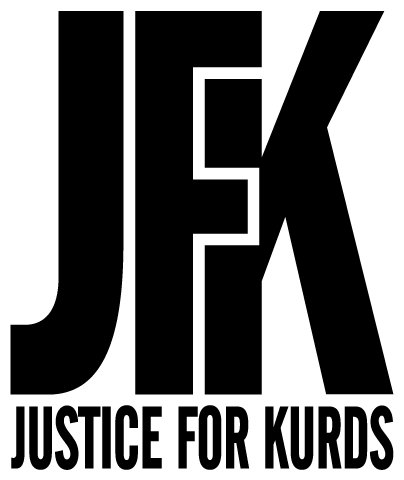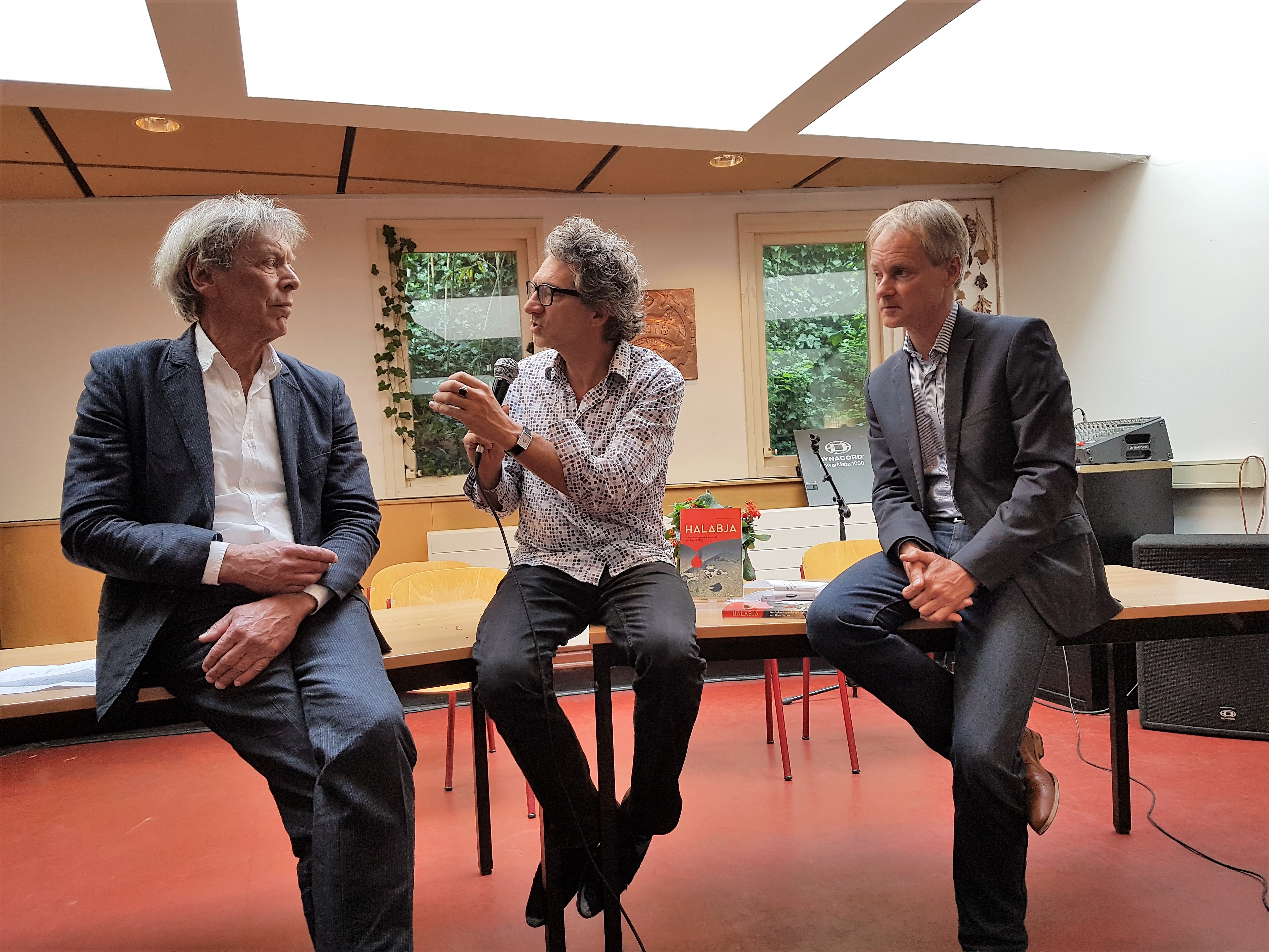We stand outside with a glass of Sauvignon blanc, a few hundred meters away from the Rijksmuseum and the ‘Gevallen Hoornblazer’ – a monument made by Gerrit Bolhuis in 1954.
Kees pulls out a box of Zwaluw matches from his jacket and lights the cigarettes of his beloved wife – Mieke – and of his publisher – Winnie. The first match lights the cigarettes of the women only, for lighting a third would bring misfortune – it captivates me.
As he lights his own cigarette with a movement that speaks of the intriguing man I have in front of me, he reflects upon his lifelong voyage in covering conflict areas in Latin America, Africa, Asia, the Middle-East and the Balkans.
Birds chirp in symphony across the parks and canals on this spring evening, while friends and colleagues have gathered at the Nelson Mandela Centre in Amsterdam.
Today, Kees Schaepman presents his new book – Aantekeningen bij de strijd om Koerdistan – which he wrote about his encounters in Halabja shortly after the chemical attack took place on March 16th, 1988.
That day, he remembers how they landed with an Sea Stallion helicopter on a valley, while shots were fired from somewhere beyond the mountains – ‘fight, fly, freeze.’ It would be his first experience as an embedded reporter in an armed conflict, which only many years later would culminate in the book he decided to write.
‘One scene in particular resonates with me. Not from the dead boys in the ditch along the road. Not from the girls in flowery dresses that I found dead in the courtyard.
Also not from the father who lies on the sidewalk in front of his house – while his arm is protectively wrapped around his little boy.
No, from all these horrific scenes, the image that resonates with me most intensely is the lifeless little black kitten in the middle of a street.
The unexpected confrontation with this poor animal, transformed all the encountered horrors that I scribbled in my notebook to comprehensible pieces of the puzzle. Who has seen the city, knows that children will play no more.’
These are some of the profound words that Schaepman shares with us on this sunny evening in the vibrant capital city of the Netherlands. In accompaniment of former MP – Harry van Bommel – who has advocated for the Kurdish cause and a memorial monument at the Dutch parliament, and, Frénk van der Linden who is also a distinguished journalist – we are witness to the stories that these gentlemen share with us today.
‘These armed conflicts have a fascinating effect on me,’ Kees says – while pointing out his privilege that he is able to experience and cover such difficult circumstances without taking up a weapon himself.’
‘Fascinating, because it allows me to see the intrinsic humans beyond the horrific crimes they inflict upon other human beings. Over the years I have come to realize how naïve I have been at certain moments in my life, especially in certain volatile circumstances during some of my journeys.’
‘And you know, as a journalist, you learn to control your emotions in vehement circumstances, because it affects your perception. It’s always the same questions that reporters face when they return from conflict areas: ‘what does it do with you, where you not scared?’
‘I often react irritably to such questions. Why should it matter? I do the work that I have chosen for, and with that, comes the professional distance and responsibility. I have to accept the consequences that it brings forth.’
The journeys abroad have also enriched him as a person and made him more optimistic for what the future holds – despite being a pessimist himself, Kees says with a smile that speaks.
‘Because of the things that I have seen, I feel the need to raise rather complicated questions about the often seemingly simple conceptions between ‘good and bad’, between ‘life and death’, as he recalls some heavy anecdotes on the Dutch resistance to the German occupation during the Second World War.
Now I’ve come to feel why for a long time Kees has been editor of Vrij Nederland, a magazine with its origins as a Dutch resistance newspaper.
His daughter Anne was around 9 years old when she found the pictures that he took in Halabja on his desk. At the time she didn’t tell her father, but when she grew older and got children of her own, he would hear that she had sleepless nights about these images.
‘She was not the only one,’ Kees admits.
‘Some years later I saw the photos of that hospital visit, wrapped in a white coat, headphones on my head, the recording equipment hangs over my shoulder, I stand beside the bed of a horrifically injured man. With a stretched arm, I hold my Sennheiser microphone in front of his mouth – my upper body seems to recoil. It felt like that microphone served as a shield, to resist the reality of that moment.’
The father of Kees was a notable diplomat, and when he came home from foreign missions in Paris, London or Bonn, he always brought back some tin soldiers. The Chasseurs à Cheval de la Garde Impériale were often leading his platoons, as Kees used to play along with his friends on the beaches of Scheveningen.
As a young man, prints hung above his bed, not from Elvis Presley and Buddy Holly, but from Eugène Delacroix, Esaias van de Velde and Jan Willem Pieneman. Many years later in Iraq, he couldn’t find any of the heroism that the painting of Pieneman embodied for him in the old days.
As the sun sets, Kees tells me that he initially doubted if he would be able to write a book on Halabja, for the gravity of the issue was one of great calibre and implication. In the end, Kees decided to write about his emotions and grief – as he says:
‘About a people who have repeatedly been abused and betrayed by the outside world. The Kurds have a long history of rebellion and broken promises behind them. Generation upon generation, men hung their rifles on their shoulders, kissed their wives and children farewell, and left to the mountains to defend their villages, their fields and their lives.’
Like a river, we linger through in-between worlds, as Kees shares his memories on a place and time, where I, was born – not so far away – some years after. It is because of people like Kees, who share their encounters with the Kurds – both through the dead and the living – that gives us the hope that someday, we may live the seasons we wished to live. No friends but the mountains, as the future lasts a long time.
I said to my soul, be still, and wait without hope,
For hope would be hope for the wrong thing; wait without love,
For love would be love of the wrong thing; there is yet faith
But the faith and the love and the hope are all in the waiting.
Wait without thought, for you are not ready for thought:
So the darkness shall be the light, and the stillness the dancing.
Whisper of running streams, and winter lightning.’
The wild thyme unseen and the wild strawberry,
The laughter in the garden, echoed ecstasy
Not lost, but requiring, pointing to the agony
Of death and birth.
T.S. Eliot – Four Quartets, 1943

